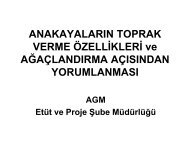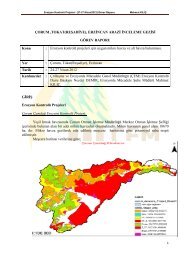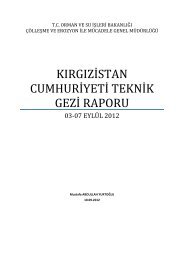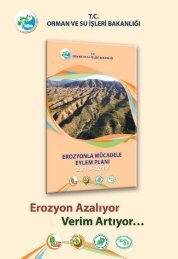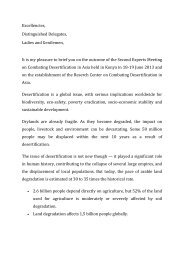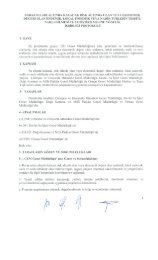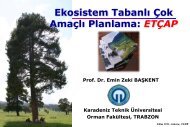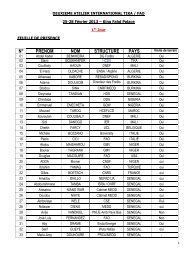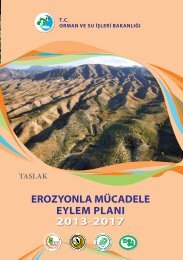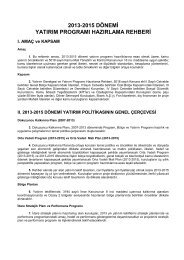Newsletter n°10: Twenty first Session of Silva Mediterranea
Newsletter n°10: Twenty first Session of Silva Mediterranea
Newsletter n°10: Twenty first Session of Silva Mediterranea
Create successful ePaper yourself
Turn your PDF publications into a flip-book with our unique Google optimized e-Paper software.
<strong>Newsletter</strong> n°10: <strong>Twenty</strong> <strong>first</strong> <strong>Session</strong> <strong>of</strong> <strong>Silva</strong> <strong>Mediterranea</strong>The State <strong>of</strong> <strong>Mediterranea</strong>n Forests (SoMF)During the 21 st session <strong>of</strong> <strong>Silva</strong> <strong>Mediterranea</strong>, the Secretariat presented the draft outline <strong>of</strong> the State <strong>of</strong> <strong>Mediterranea</strong>nForests (SoMF 2012). The Committee adopted the proposed draft plan <strong>of</strong> the SoMF with the following recommendations: Add a sub-chapter under the chapter 4 on Climate Change on„‟adaptive management <strong>of</strong> <strong>Mediterranea</strong>n forests‟‟ (sylviculture); Add in the sub-chapter on legislation one analysis <strong>of</strong> forest policies inthe region and, also, identification <strong>of</strong> existing instruments; Reinforce chapter 1 on the „‟<strong>Mediterranea</strong>n Context‟‟ with a solidanalysis on social changes/global changes in the region; Clarify the definition <strong>of</strong> <strong>Mediterranea</strong>n forests in the map presentedon the basis <strong>of</strong> the Remote Sensing Survey 2011 (<strong>Mediterranea</strong>nForests / Non <strong>Mediterranea</strong>n Forests); Take into consideration available data in existing regional/nationalstates <strong>of</strong> forests (Catalunya, PACA region, Tuscany, GIS data could beavailable from Turkish Forest Map under the GDF, etc...); Give more emphasis to data and analysis <strong>of</strong> land ownership (private and public) and access <strong>of</strong> local communitiesto forest resources and multiple ecosystem services; Put additional efforts into using this opportunity (SOMF preparation in 2012) to fill gaps when possible (data onsocial issues/ data on ecosystem goods and services provided by <strong>Mediterranea</strong>n forests).On the basis <strong>of</strong> these recommendations, the final outline <strong>of</strong> the SoMF 2012 should be:I. The <strong>Mediterranea</strong>n context: changes and prospects1.1. A region under economic, social, environmental and political changes1.2. Increasing pressure on the environment: climate change and human activitiesII. State and roles <strong>of</strong> forest resources in the <strong>Mediterranea</strong>n region2.1. Assessment <strong>of</strong> changes in <strong>Mediterranea</strong>n forest areas2.2. Biotic and abiotic disturbances2.2.1 Forest fires: assessment and risk evaluation2.2.2 Insects and diseases2.2.3 Other disturbances2.3. Goods and services provided by <strong>Mediterranea</strong>n forest ecosystems2.3.1 <strong>Mediterranea</strong>n forests and water-related services2.3.2 <strong>Mediterranea</strong>n forests and Non-Wood Forest Products (NWFP)2.3.2.1 Cork oak in <strong>Mediterranea</strong>n forests2.3.2.2 Stone Pines (Pinus Pinea) in <strong>Mediterranea</strong>n forests2.3.2.3 Other NWFP (Thyme, Sage, Laurel...)2.3.3 Other goods and services provided by <strong>Mediterranea</strong>n forests (including Ecotourism and recreational functions)2.4. Urban and Peri-urban Forests in the <strong>Mediterranea</strong>nIII. Forest policies, institutions and legal frameworksIV. <strong>Mediterranea</strong>n forests and climate change4.1. Forest Genetic Resources (FGR): a key issue for adaptation <strong>of</strong> <strong>Mediterranea</strong>n forest ecosystems4.2. Forest fire prevention under new climatic conditions4.3. Impacts <strong>of</strong> climate change on insects and diseases in <strong>Mediterranea</strong>n forests4.4. Adaptive silvicultural and restoration practices in <strong>Mediterranea</strong>n forests4.5. Climate change mitigation by forests and financing opportunities through the Reducing Emissions fromDeforestation and Forest Degradation mechanism (REDD+)V. Some key management issues at landscape/territorial level (7/8 landscapes to be chosen in order to highlightspecific <strong>Mediterranea</strong>n forestry questions: impacts <strong>of</strong> global changes on cork oak landscapes, forest fires prevention atlocal level, adaptative silvicultural practices, fight against erosion and desertification through forest landscape restoration,PES Schemes, Watershed management, Tourism and Non Wood Forest Products).Valentina GARAVAGLIA (FAO)For further information, please contact Valentina GARAVAGLIA (valentina.garavaglia@fao.org) or Christophe BESACIER(christophe.besacier@fao.org) at the FAO Secretariat <strong>of</strong> the Committee on <strong>Mediterranea</strong>n Forestry Questions-<strong>Silva</strong> <strong>Mediterranea</strong>.<strong>Silva</strong> <strong>Mediterranea</strong> <strong>Newsletter</strong> n 0 10 - March 2012 - http://www.fao.org/forestry/silvamed 5



